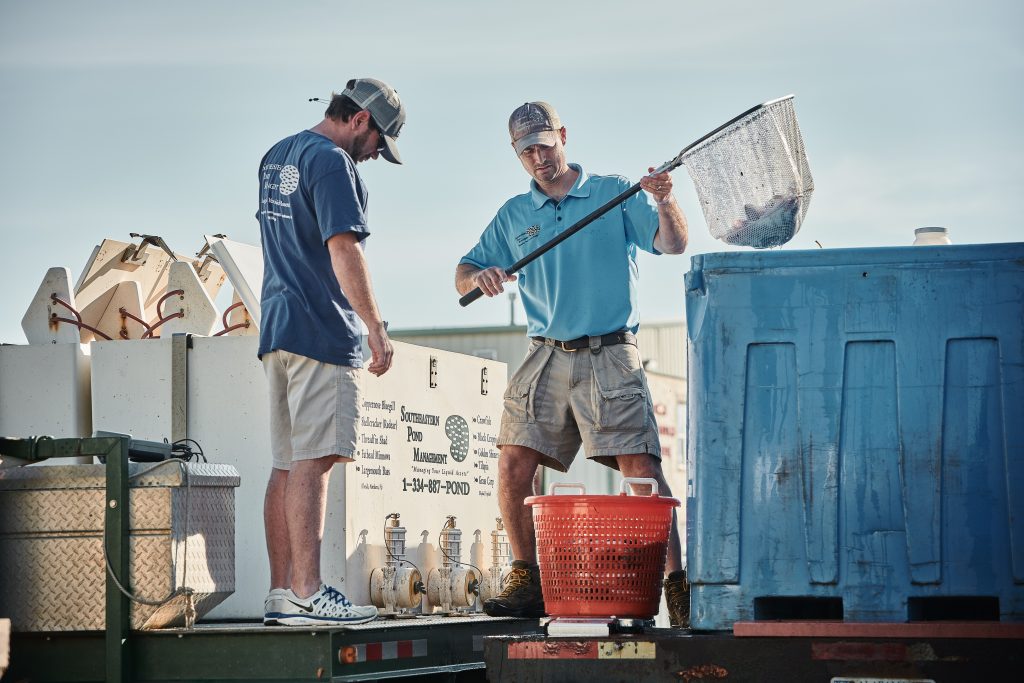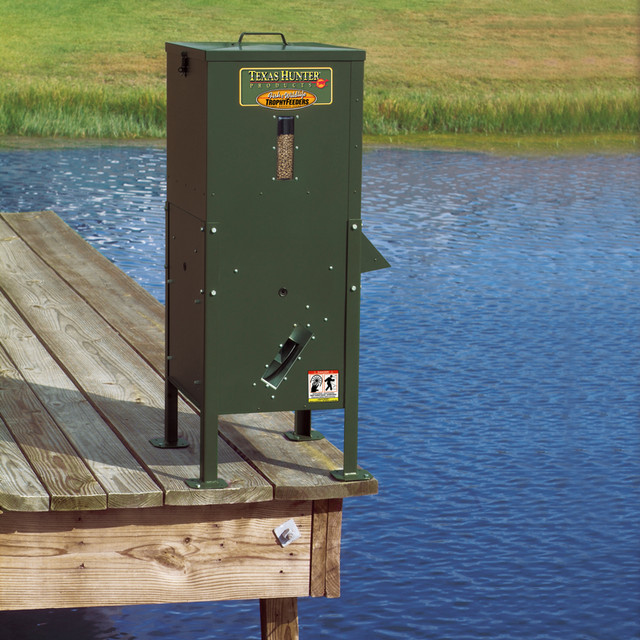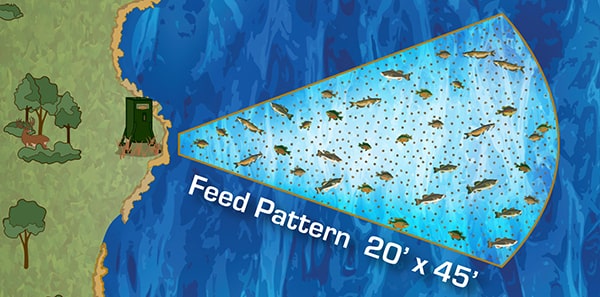In theory, a pond with a balanced ratio of “predator to prey” fish shouldn’t need supplemental feeding from a pond fish feeder to support the fish population. If the forage fish base of bluegill and threadfin shad (plus whatever else is in there) are healthy and reproduce, it should be self-sustaining and plentiful enough to keep the predator population, predominantly bass, healthy and growing.
Sometimes though nature has a way of interfering with even the best laid plans of mice and men. Bass are ravenous feeders and can clean out the food pantry pretty fast.
Then again…
Maybe the bass population has increased to the point where they have decimated the forage fish base. Maybe the forage fish didn’t have a good spawning year and the pond is now out of “predator prey” balance and needs to be brought up to speed. This imbalance of too many predator fish with not enough forage fish in a pond is what is called a “predator crowded” situation.
Norman Latona is founder and president of Southeastern Pond Management. SE Pond offers services that cover the waterfront of pond development and management including ecosystem analysis, management programs, pond construction, liming, fertilizing, fish inventory assessment, removal processes, stocking of forage and game fish, maintenance and more. They cover the Southeast and do projects in other areas such as Illinois and as far west as Arkansas and Texas.

“Largemouth bass like to eat, eat and eat and they can eat themselves out of house and home especially if pond owners don’t make sure that there is a good balance between the predator bass population and the forage fish population,” Latona said. “With largemouth bass it is hard to keep groceries around.”
Research shows that a bass needs to eat 8-10 pounds of food in order to gain one pound of weight. If the goal is to grow bigger bass a pond owner needs to understand that in order to grow bigger bass, he/she needs fewer bass. It is an inverse relationship. Research also suggests that a healthy prey to predator ratio is approximately in the one to three or four range. That means for every bass there should be three to four forage fish.
“A common condition that we encounter is what we call ‘predator crowding’, which is where the bass are abundant but they are skinny and run in the 12-14-inch range and predator fish harvest is the first line of defense with forage fish stocking coming afterwards,” Latona noted. “Harvest removes mouths and stocking adds food to the mouths we have.”
According to Latona, while you can try to remove excess predators by “hook and line” the easiest and most efficient way to reduce the predator population to a reasonable level in relationship to the forage fish population is to “electrofish”.
The electrofishing process relies on two electrodes which deliver current at high-voltage from the “anode” to the “cathode” through the water. When a fish encounters the electric pulses, it causes what is called “galvanotaxis” which is uncontrolled muscular convulsion and the result is that the stunned fish swims towards the anode where it is netted and information collected. The whole process doesn’t harm the fish, allows for selective data capture and can be done year-round.
“Electrofishing is very efficient in terms of harvesting fish and since our goal is to remove as many pounds of fish per hour as we can we tend to do more of that in the spring and fall because that is when the fish are normally in shallower water,” Latona said. “Electrofishing really shines and is tremendously effective in shallower water.”
Once the proper prey to predator balance has been established one way to help maintain that healthy ratio is to start a supplemental feeding program.
Benefits of Supplemental Feeding
The term, “supplemental feeding” is not only a misnomer but doesn’t do justice to the benefits that it provides. Using a pond fish feeder is actually part of the overall plan and is a large contributor to the ultimate success of the pond management program and isn’t just a “add on”
First off, feeders help support the pond food chain. Sometimes due to a low level of Phytoplankton, a pond can’t support the smaller fish and if there aren’t smaller fish the bigger fish (as in bass) go hungry and become stunted. Bluegill, gizzard shad, golden shiners and even flathead minnows along with channel catfish and trout eat fish food.

Fish pellets help the forage base grow therefore providing more food for the predators. Healthier fish mean bigger fish. Supplemental feeding may even increase the frequency of spawning in the forage base.
In addition, setting up a consistent feeding schedule induces the baitfish to congregate and creates a “feeding zone”. Where the baitfish go, the predators will follow so you have a concentration of catchable bass in a little area. How much fun is that?
“Supplemental forage fish feeding is a useful and productive management input aimed at providing a nutritional boost to the bluegill and other species as well as concentrating them into an area making them easier to catch and can produce some lunkers. The healthier the bluegill are the more they will reproduce and that means more fry for the bass to eat,” Latona said. “Everybody gets bigger and it contributes to the overall health of the pond’s ecosystem.”
Pond Fish Feeder Options
While there are a lot of pond fish feeder companies. Latona thinks highly of Texas Hunter Products.
“We are big believers in Texas Hunter Products feeders. Simply put, they are well designed and built and deliver on time, every time. The key to a successful supplemental feeding program is reliability and consistency,” Latona said.
Texas Hunter Products offers standard directional pond fish feeders in different capacities (70, 125 and 250 pounds) along with a hanging fish feeder. The directional fish feeder units feature a digital timer that can feed up to nine times a day, an air blower system and dispenses feed in a 20-foot by 45-foot wedge pattern which creates that feeding zone.

“Texas Hunter Products directional fish feeders are designed specifically for mounting on the pond bank (adjustable legs) or on a dock (dock legs). Coupled with a rechargeable 12-volt battery and solar charging panel, the only challenge is keeping them full of fish food!” Latona said. “They may be programmed to deliver a measured quantity of fish food multiple times throughout the day and we find that feeding bluegill more than once during the day (morning, midday, afternoon) tends to increase the total amount they are willing to consume.”
“Feeding bluegill a high-protein ration on a daily basis during the growing season (March through October) dramatically increases growth rates and top-end size. In addition, feeders attract bluegill (and other species), making them easier to catch and/or harvest,” Latona explained. “Supplemental feeding is one of those ‘add-on’ management inputs that can really push your pond to the next level and it is an integral part of the management program.”
“I cannot emphasize enough the importance of utilizing supplemental feeders not only from the health of the fish population perspective but the fun that it can generate. When you place some feeders on the pond and program them to disperse pellets at consistent times you create feeding zones at certain times,” Latona said. “That means fun for you, your kids and even grandkids because you are guaranteed to catch fish at certain times in specific areas and that is what lasting memories are made of,” Latona concluded.




